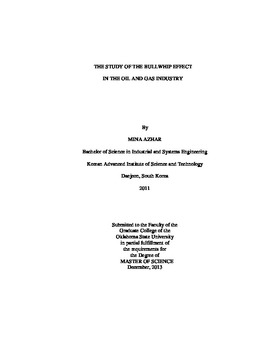| dc.contributor.advisor | Liu, Tieming | |
| dc.contributor.author | Azhar, Mina | |
| dc.date.accessioned | 2015-06-17T20:04:40Z | |
| dc.date.available | 2015-06-17T20:04:40Z | |
| dc.date.issued | 2013-12-01 | |
| dc.identifier.uri | https://hdl.handle.net/11244/14704 | |
| dc.description.abstract | The New Product Development Center (NPDC) at Oklahoma State University (OSU) received problems reported by oil equipment suppliers. The specific problems the oil equipment suppliers experienced were frequent large labor adjustments due to large spikes in demand along with cyclic periods of high and low demand. When looking at data from the New York Stock Exchange (NYSE), it appeared that demand variability increased as it went up the supply chain in the oil and gas industry. From a supply chain management perspective, the specific problems reported by the oil equipment suppliers are similar to symptoms a company in an industry with the bullwhip effect present would experience. The investigation of this phenomenon used firm level data through a defined direct link of the levels in the oil and gas supply chain. Three research questions were posed: if the bullwhip exists in the oil and gas industry; if the highest level in the defined supply chain experiences the highest amount of demand variability; and if smaller sized companies are more susceptible to the bullwhip effect. The following results were found: most of the companies in the study and in the supply chain showed evidence of the bullwhip effect presence; the highest level in the supply chain did not appear to experience largest amount of demand variability; and the smaller companies demonstrated larger bullwhip effects. Other than the research questions, the study also provided evidence that: cyclicality was not widespread, but the largest demand was generally experienced by companies in the fourth quarter and lowest demand generally seen in the first quarter; larger integrated companies exhibited a lower bullwhip effect than smaller integrated companies; and the upstream level exhibited the largest bullwhip effect while the drilling and service and equipment level showed continuous improvement during the oil crisis in 2008 | |
| dc.format | application/pdf | |
| dc.language | en_US | |
| dc.publisher | Oklahoma State University | |
| dc.rights | Copyright is held by the author who has granted the Oklahoma State University Library the non-exclusive right to share this material in its institutional repository. Contact Digital Library Services at lib-dls@okstate.edu or 405-744-9161 for the permission policy on the use, reproduction or distribution of this material. | |
| dc.title | Study of the Bullwhip Effect in the Oil and Gas Industry | |
| dc.type | text | |
| dc.contributor.committeeMember | Tilley, Daniel | |
| dc.contributor.committeeMember | DeYong, Camille | |
| osu.filename | Azhar_okstate_0664M_13145.pdf | |
| osu.accesstype | Open Access | |
| dc.description.department | Industrial Engineering & Management | |
| dc.type.genre | Thesis | |
| dc.subject.keywords | bullwhip effect | |
| dc.subject.keywords | demand variability | |
| dc.subject.keywords | oil and gas | |
| dc.subject.keywords | supply chain | |
